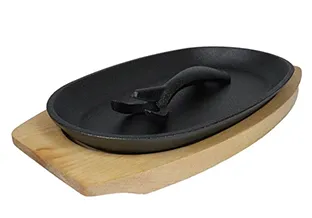
restoring iron skillet
Restoring an Iron Skillet A Guide to Reviving Your Kitchen Classic
Iron skillets are a kitchen staple that can last a lifetime with proper care. However, years of neglect or improper cleaning can lead to a cast iron skillet that is rusty, sticky, and seemingly beyond repair. Fortunately, restoring an iron skillet is not only possible but also rewarding. This guide will walk you through the steps to breathe new life into your beloved cookware.
Assessing the Condition of Your Skillet
Before diving into the restoration process, carefully examine your skillet. If it’s simply coated with burnt-on food or has a bit of rust, you’re in for a relatively easy clean-up. However, if the skillet has deep rust spots or significant corrosion, more intensive work may be required. Either way, the journey to restoring your skillet starts with a good clean.
Step 1 Gather Your Supplies
You'll need a few items before getting started
- Steel wool or a scrub brush - Dish soap - Baking soda - Vinegar (if rust is present) - Cooking oil (flaxseed, vegetable, or canola oil are good choices) - Paper towels or a clean cloth - An oven
Step 2 Cleaning the Skillet
restoring iron skillet

Begin by scrubbing the skillet with steel wool and dish soap. This initial scrub will help remove any stuck-on food and begin the rust removal process. For deeper rust, you may need to use a mixture of equal parts vinegar and water. Soak the rusty areas for a few hours, then scrub gently. Once you’re satisfied with the cleanliness, rinse the skillet thoroughly and dry it immediately to prevent further rust.
Step 3 Seasoning Your Skillet
Once clean and dry, it's time to season your skillet. Seasoning creates a non-stick surface and protects the skillet from moisture. Preheat your oven to 375°F (190°C). Apply a thin layer of oil to the entire skillet using a paper towel, making sure to cover the bottom and sides evenly. It’s important not to use too much oil; excess can lead to a sticky surface.
Place the skillet upside down in the oven to catch any drips. To avoid any unwanted mess, place a sheet of aluminum foil on the rack below. Bake the skillet for about an hour, then turn off the oven and let it cool inside. This process allows the oil to bond with the iron and establish a protective coating.
Step 4 Regular Maintenance
Now that your skillet is restored, proper maintenance is crucial to ensure its longevity. After each use, avoid using soap; instead, scrub it with hot water and a brush. For heavily soiled pans, a paste of baking soda and water can be effective. Always dry the skillet thoroughly to avert rust formation and apply a light coat of oil before storing.
Conclusion
Restoring an iron skillet may seem like a daunting task, but with a little patience and effort, you can return it to its former glory. This classic kitchen tool is not just a cooking implement; it holds memories of family meals and cherished recipes. By taking the time to restore and care for your cast iron skillet, you are investing in a product that can serve you for generations. So roll up your sleeves, grab that neglected skillet, and embark on the journey to restoration—your culinary adventures await!
-
Season Cast Iron Perfectly with GPT-4 Turbo TipsNewsAug.01,2025
-
High Quality Cast Iron Cookware - Baixiang County Zhongda MachineryNewsAug.01,2025
-
Premium Cast Iron Pan: Durable & Perfect HeatNewsAug.01,2025
-
High Quality Kitchen Durable Black Round Cast Iron Cookware Pancake Crepe Pan-Baixiang County Zhongda Machinery Manufacturing Co., Ltd.NewsAug.01,2025
-
Cast Iron Cookware - Baixiang County Zhongda Machinery | Nonstick, Heat ResistanceNewsAug.01,2025
-
High Quality Kitchen Durable Black Round Cast Iron Cookware - Baixiang County Zhongda Machinery | Non-Stick, Heat Retention, DurableNewsJul.31,2025


